Sistema di sorveglianza OKkio alla SALUTE: risultati 2010 - Istituto ...
Sistema di sorveglianza OKkio alla SALUTE: risultati 2010 - Istituto ...
Sistema di sorveglianza OKkio alla SALUTE: risultati 2010 - Istituto ...
Create successful ePaper yourself
Turn your PDF publications into a flip-book with our unique Google optimized e-Paper software.
Rapporti ISTISAN 12/14<br />
attività sportiva strutturata, mentre sono comuni i comportamenti sedentari come guardare la TV<br />
o usare i videogiochi per <strong>di</strong>verse ore al giorno.<br />
La scarsa attività fisica e l’aumento della sedentarietà possono essere fronteggiate pianificando<br />
un approccio che includa <strong>di</strong>verse strategie <strong>di</strong> intervento che non mirino esclusivamente al singolo<br />
in<strong>di</strong>viduo, ma che tengano conto anche del contesto sociale-urbanistico in cui esso vive. Infatti,<br />
così come in<strong>di</strong>cato nella “Carta dell’attività fisica” <strong>di</strong> Toronto (2), la possibilità <strong>di</strong> svolgere attività<br />
fisica è influenzata dalle politiche in materia <strong>di</strong> istruzione, trasporti, parchi e urbanistica.<br />
Un luogo fondamentale per la promozione <strong>di</strong> politiche <strong>di</strong> intervento è sicuramente la scuola<br />
dove i bambini trascorrono il 40% del loro tempo; migliorare il percorso casa-scuola, con la<br />
creazione <strong>di</strong> piste ciclabili e percorsi sicuri per i pedoni (11), così come aumentare le ore <strong>di</strong><br />
attività motoria nel curriculum scolastico (12), possono rivelarsi strategie vincenti.<br />
Infine, affinché anche la famiglia abbia un ruolo fondamentale nell’influenzare i<br />
comportamenti dei bambini, occorre aiutare i genitori a comprendere i benefici salutari del<br />
movimento per sé e per i propri figli.<br />
Bibliografia<br />
1. Branca F, Nikogosian H, Lobstein T. The challenge of obesity in the WHO European Region and the<br />
strategies for response. Summary. Geneva: WHO; 2007. Traduzione italiana a cura del Ministero della<br />
Salute e d<strong>alla</strong> Società Italiana <strong>di</strong> Nutrizione Umana, stampata nel 2008. La sfida dell’obesità nella Regione<br />
europea dell’OMS e le strategie <strong>di</strong> risposta. Compen<strong>di</strong>o. Disponibile all’in<strong>di</strong>rizzo:<br />
http://www.sinu.it/documenti/OMS%20La%20Sfida%20dell'Obesit%C3%A0%20e%20le%20Strategie%<br />
20<strong>di</strong>%20Risposta%20CCM%20SINU.pdf; ultima consultazione 17/5/2012.<br />
2. Global Advocacy Council for Physical Activity, International Society for Physical Activity and Health. La<br />
Carta <strong>di</strong> Toronto per l’Attività Fisica: una chiamata globale all’Azione. Disponibile al sito:<br />
http://www.globalpa.org.uk/pdf/torontocharter-italian-20may<strong>2010</strong>.pdf . Ultima consultazione 1/6/2012.<br />
3. Gortmaker SL, Swinburn BA, Levy D, Carter R, Mabry PL, Finegood DT, Huang T, Marsh T, Moo<strong>di</strong>e<br />
ML. Changing the future of obesity: science, policy, and action. The Lancet 2011;378:838-47.<br />
4. Hardy LL, Dobbins TA, Denney-Wilson EA, Okely AD, Booth ML. Sedentariness, small-screen<br />
recreation, and fitness in youth. Am J Prev Med 2009; 36:120-5.<br />
5. Hancox RJ, Poulton R. Watching television is associated with childhood obesity: but is it clinically<br />
important? International Journal of Obesity 2006;30:171-5.<br />
6. Steffen LM, Dai S, Fulton JE, Labarthe DR. Overweight in Children and Adolescents Associated with TV<br />
Viewing and Parental Weight: Project HeartBeat! Am J Prev Med. 2009;37:S50-S55.<br />
7. H<strong>alla</strong>l PC, Victora CG, Azevedo MR, Wells JC. Adolescent Physical Activity and Health. Sports Med<br />
2006;36:1019-30.<br />
8. World Health Organization. Global Strategy on <strong>di</strong>et, physical activity and health. Geneva: WHO; 2004.<br />
9. Shofan Y, Kedar O, Branski D, Berry E, Wilschanski M. A school-based program of physical activity<br />
may prevent obesity. Eur J Clin Nutr 2011;65:768-70.<br />
10. US Department of Health and Human Services. NIH. We can. Families. Fin<strong>di</strong>ng the balance. A parent<br />
handbook. Disponibile all’in<strong>di</strong>rizzo: http://www.nhlbi.nih.gov/health/public/heart/obesity<br />
/wecan_mats/parent_hb_en.pdf; ultima consultazione 27/5/2011.<br />
11. Kenneth RF. Childhood obesity and the role of physical activity. The journal of The Royal Society for the<br />
Promotion of Health 2003;124:34-39.<br />
12. UK Government. Directgov. Children and healthy weight. Disponibile all’in<strong>di</strong>rizzo:<br />
http://www.<strong>di</strong>rect.gov.uk/en/Parents/Yourchildshealthandsafety/YourChildsHealth/DG_066077 ; ultima<br />
consultazione 27/5/2011.<br />
55


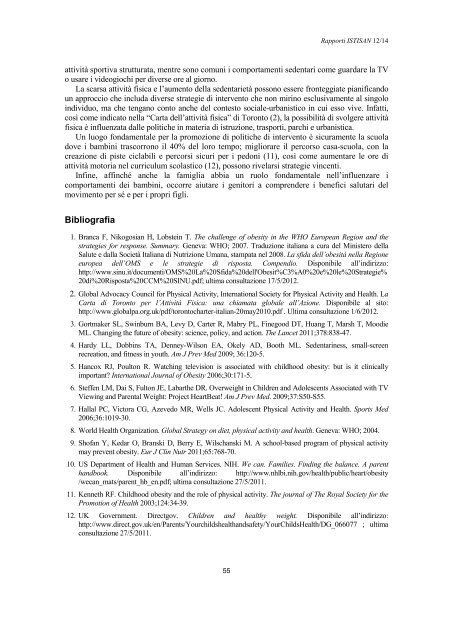
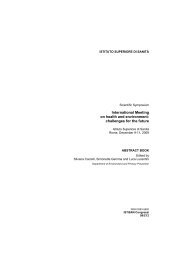
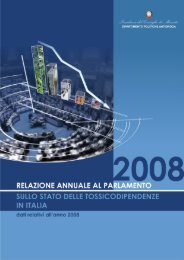
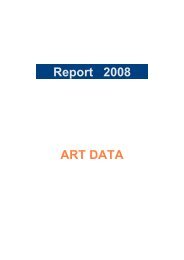
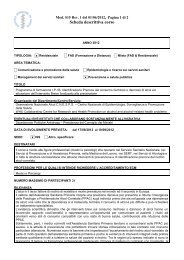
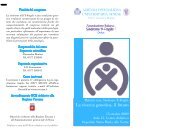
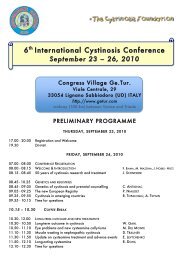
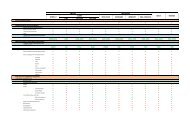
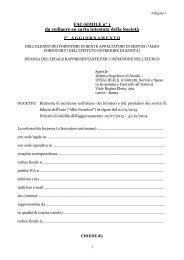

![Emilia Romagna [PDF - 175.10 kbytes]](https://img.yumpu.com/23556597/1/184x260/emilia-romagna-pdf-17510-kbytes.jpg?quality=85)

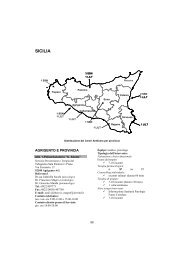
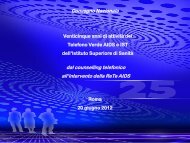
![Istisan Congressi N. 66 (Pag. 1 - 81). [PDF - 2021.12 kbytes] - Istituto ...](https://img.yumpu.com/23556493/1/171x260/istisan-congressi-n-66-pag-1-81-pdf-202112-kbytes-istituto-.jpg?quality=85)